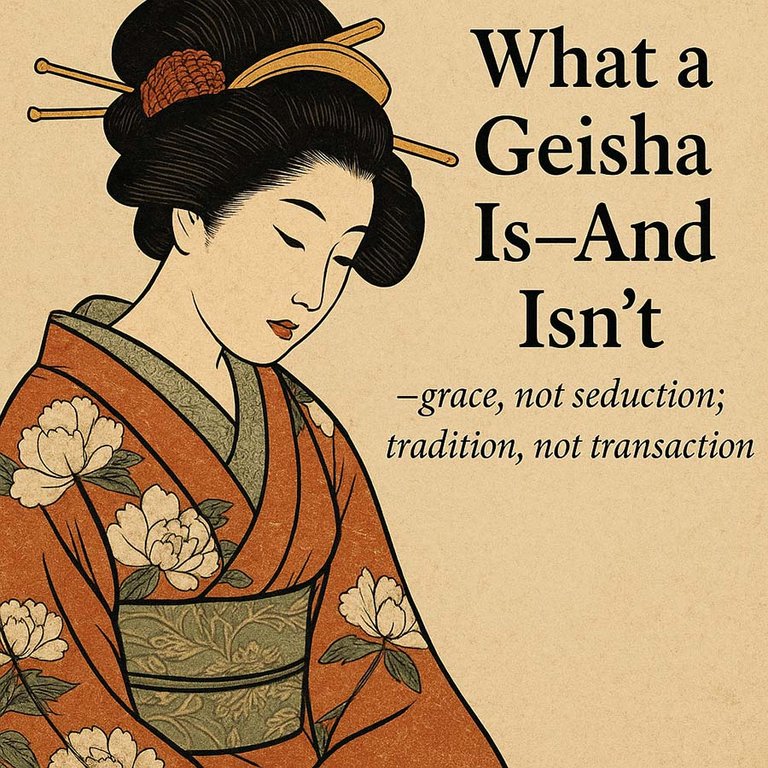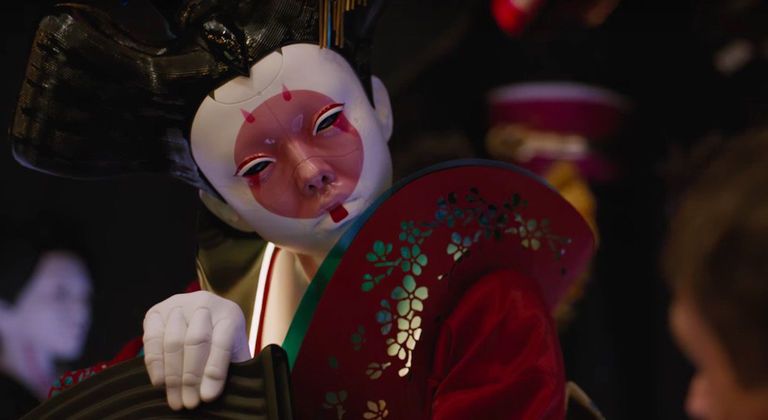There are few Japanese words as globally recognizable — and as widely misunderstood — as geisha.[1]
A few weeks ago I wrote a brief post about why geisha wear wigs and paint their faces white. (See it here). @bozz left a comment with the innocent question “Just what is a geisha?” I gave him a simple reply, but it got me thinking. I soon was writing down a much longer bit that became this post.
So let’s talk about just what a geisha is — and what a geisha isn’t.

In the West, the term was long misused, mistranslated, and flattened into something it never was. For decades, many Americans thought a geisha was just a fancy kind of prostitute in a kimono. This confusion wasn’t just a simple cultural misstep. It came from something very real and very specific: after the war, a number of sex workers catering to U.S. soldiers styled themselves as “geisha”, knowing the word carried exotic allure and would command higher prices. These women had nothing to do with the centuries-old geisha tradition, but the damage was done.[2]
It stuck. The myth made its way into pop culture, into movies, into the American imagination — and stayed there.
So… What Is a Geisha?
The word geisha (芸者) literally means “art person” or “artist”. That’s the key. A geisha is not a courtesan, nor an escort, nor a companion in any romantic sense. She is a performing artist. A professional entertainer. A living, breathing vessel of Japanese traditional culture.
She’s trained in the arts of music, dance, song, conversation, etiquette, and seasonal knowledge.[3] She plays shamisen, performs nihon buyō dances, composes haiku, recites classical poetry, and knows the proper way to serve tea or sake depending on the time of year. She’s fluent in the subtle art of being entertaining without being flirtatious — an incredibly difficult balancing act that few in the West fully appreciate.
Traditionally, the role of a geisha was to bring elegance and refinement to a gathering. She might perform at a high-end banquet, a ryōtei (exclusive restaurant), or an intimate ozashiki (tatami-matted room) affair. The mood she creates is artful and often playful — but it is not sexual.
If you think about it, there’s no true Western counterpart. A geisha is part performing artist, part host, part connoisseur, part historian. The closest might be a hybrid of an elite cultural ambassador and a cabaret performer — if the latter had studied for ten years and could recite The Tale of Genji from memory.
The Price of Art
Hiring a geisha isn’t just expensive — it’s exclusive. And it’s a far cry from transactional sex work.
A modest evening with one geisha and one apprentice (maiko) might start around ¥100,000 (roughly $650). But full-scale events with multiple geisha, musicians, and a course meal at a luxury ryōtei easily reach ¥500,000 to ¥1,000,000 ($3,000–$7,000). It’s not uncommon for an evening to hit the $10,000 mark once all expenses are included — food, drink, performance, tip, and more.
This aligns them less with any notion of “escort service” and more with high-end cultural speakers or performers at elite corporate events in the West. Those $10,000 speakers, however, are fairly easy for corporations to find and hire. Geisha are far more exclusive; you can’t just hire one off a website.
Access usually requires a personal referral, known as a tsukiai. The geisha world is built on trust, introductions, and reputation. If you flake on a bill, your name is mud — not just in that district, but potentially across Japan’s entire geisha network. It’s a closed world, where tradition matters, and discretion is paramount.
A Life of Training and Discipline
Becoming a geisha is no easy feat. Traditionally, a girl might begin her training as a shikomi (a sort of housemaid and observer), then become a minarai (learning by watching her older sisters), and finally an apprentice, or maiko in Kyoto dialect. This apprenticeship could last five years or more before she “debuted” as a full geisha.
During this time, she lives under strict rules — no dating, no personal cell phones, no side jobs. Even today, in the few remaining geisha districts of Kyoto and Kanazawa, the expectations remain intense. You live in a shared house, wear traditional clothes, speak with formal language, and learn from your seniors. It’s a life of beauty, yes, but also discipline, self-sacrifice, and physical exhaustion. The hairpieces alone are heavy enough to make your neck ache. And many maiko suffer from burned scalps because their hair must be styled with heated irons and worn for days at a time, including when sleeping on a wooden neck block.
It’s not something anyone casually signs up for. Which is why it’s particularly frustrating to those inside the profession when outsiders casually — or cynically — collapse it into sex work.
The Postwar Misuse
So how did we get here? How did “geisha” become a euphemism for “prostitute” in postwar America?
After Japan’s surrender in 1945, the occupying forces flooded cities like Tokyo and Yokohama. U.S. soldiers with money and curiosity sought out “authentic” Japanese experiences — and were often met by women dressed in kimono calling themselves “geisha girls”. These women were sex workers. They adopted the look and the name because the real geisha were closed off, too expensive, and frankly not interested in entertaining drunken foreign soldiers.
And can you blame them?
Meanwhile, Japan’s shattered economy and power vacuum created an enormous black market, including a vast informal sex industry. Many of these “geisha girls” weren’t trained entertainers at all, but ordinary women trying to survive in a devastated, occupied nation. Still, the term stuck. To the average GI, they were “geisha”. And that’s what they told their buddies back home.
Hollywood took it from there.
Hollywood sealed the myth with films like Sayonara and Memoirs of a Geisha, which romanticized the idea of the beautiful, tragic courtesan. These movies blended aesthetics with innuendo, art with desire — effectively erasing the real role geisha played in Japanese society.
It’s only in recent years that the true identity of the geisha has started to be more widely understood outside of Japan.
Geisha ≠ Courtesan: Understanding the Difference
To really grasp the distinction, we have to go back to the Edo period.
Japan once had a well-defined class of sex workers called yujo (遊女), a term that literally means “play women”. Among them, the most elite were the oiran (花魁), high-ranking courtesans of the licensed pleasure districts like Yoshiwara. Oiran were educated, fashionable, and selective. They performed music and poetry, and their processions down the street were public spectacles. You might be forgiven for thinking that sounds a little like my description of a geisha above. Maybe so, but the big difference being oiran were still sex workers — albeit expensive ones. Think escorts — the kind of call girl that only the rich can afford.
Geisha, by contrast, were originally entertainers who performed alongside these women, not as rivals but as artistic complements. Over time, geisha became independent from the pleasure quarters and formed their own world of performance and culture. By the late 1800s, they had clearly split off into their own category. No sex. Just art.
That line has remained firm in Japan. It’s only abroad where it became blurry.
A Role in Modern Japan
Today, only a few hundred geisha remain active, mostly in Kyoto, Kanazawa, and Tokyo’s Asakusa district. Their numbers have shrunk, but their role remains vital. They preserve traditional dance, song, seasonal customs, and even modes of speech that would otherwise vanish.
You’re unlikely to meet one unless you’re invited to a very formal event or have deep connections in Kyoto. It can happen. I have a foreigner friend who lives in Kyoto and has managed to work himself into the geisha world as a photographer. He goes to their events. He is allowed to participate a little, but he is mostly limited to watching and taking photos.
But even if you manage to do as he has and find yourself invited to a geisha event, it won’t be anything like what you saw in Memoirs. No mysterious seduction. No tragic love story. No sex. Just quiet, practiced elegance. A flick of the wrist. A haunting shamisen note. A perfectly timed seasonal joke.
Geisha are not relics of a lost world. They are practitioners of one still alive — if only barely — amid the noise and neon of modern Japan.
❦
-
Just to be clear, that is pronounced gay-sha. I think that’s pretty well-known at this point, but I also know many Boomers still insist on pronouncing it as gee-sha, evidently because that is how it was pronounced on McHale’s Navy, a popular sitcom that was on when they were kids. ↩
-
I have another post in the works addressing this point. In brief: the sex-work industry in Japan for American GIs following the war was huge — and the women providing the services not always doing so of their own free will. ↩
-
Kind of a lot of the stuff I share here, about the traditional Japanese almanac, about season words in haiku, and so on. The difference is much of my knowledge is in my notebooks (or in my Zettelkasten), whereas geisha have it all memorized and are experts in all of it. ↩




